Financial Analysis and Valuation of Gazprom Ltd. - Report
VerifiedAdded on 2020/10/22
|9
|2522
|443
Report
AI Summary
This report provides a detailed financial analysis of Gazprom Ltd., a Russian natural gas company. It begins with an introduction to financial market and investment analysis, followed by an overview of Gazprom's operations and financial performance, including revenue, operating profit, and assets. The report explores various valuation methods, such as book value, equity valuation, dividend valuation, and free cash flow, and applies them to Gazprom. It examines the assumptions used in these valuations, analyzes the results, and discusses large market movements and the efficient market hypothesis. Additionally, the report touches upon unconventional monetary policy tools and their impact. The analysis includes key financial data and critical price movements, linking them to central bank policies and investment decisions. The report concludes with an assessment of Gazprom's financial health and investment potential, offering insights into its performance and market position. Finally, the report also includes a discussion of British American Tobacco (BAT) and reconciles share price movements with the efficient market hypothesis.

FINANCIAL MARKET AND
INVESTMENT ANALYSIS
INVESTMENT ANALYSIS
Paraphrase This Document
Need a fresh take? Get an instant paraphrase of this document with our AI Paraphraser
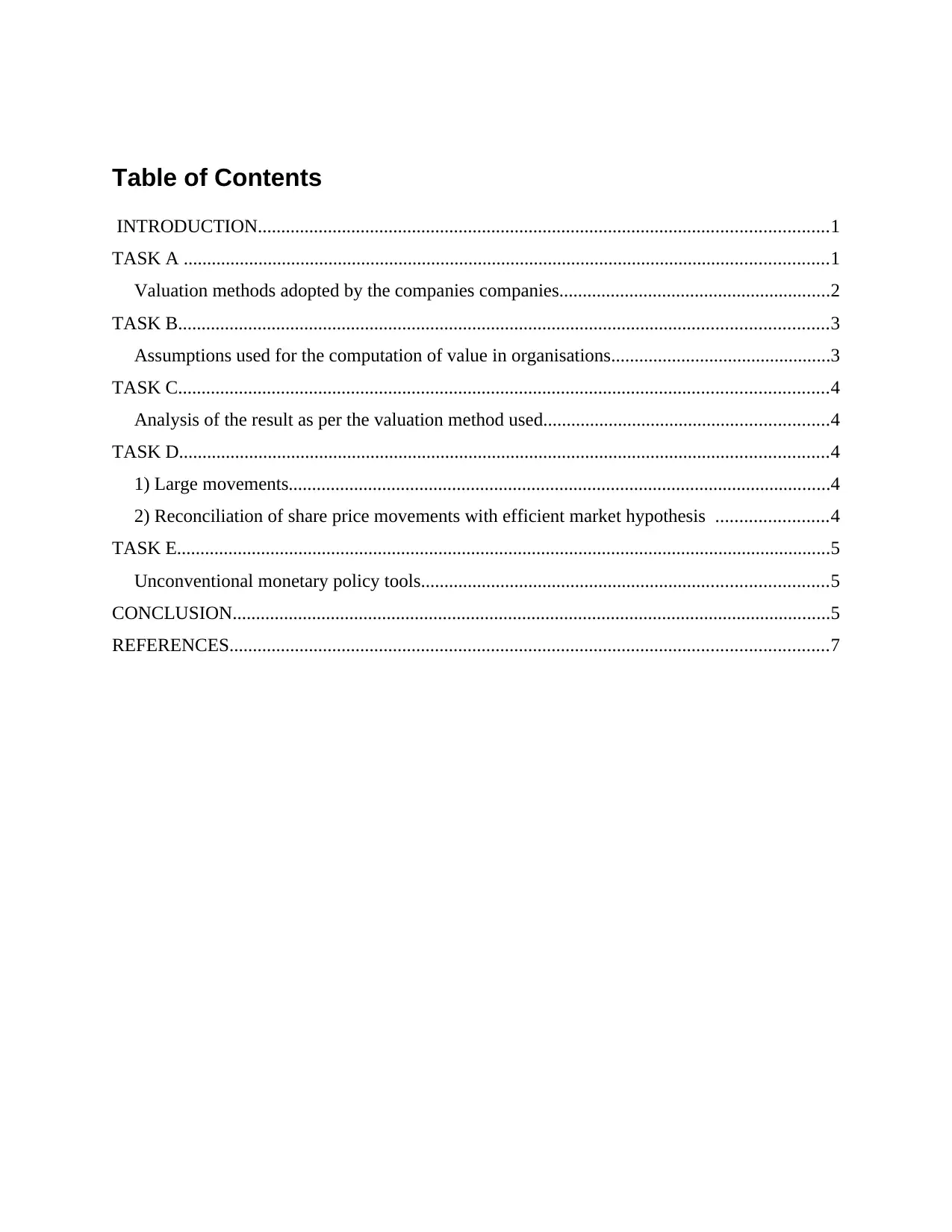
Table of Contents
INTRODUCTION..........................................................................................................................1
TASK A ..........................................................................................................................................1
Valuation methods adopted by the companies companies..........................................................2
TASK B...........................................................................................................................................3
Assumptions used for the computation of value in organisations...............................................3
TASK C...........................................................................................................................................4
Analysis of the result as per the valuation method used.............................................................4
TASK D...........................................................................................................................................4
1) Large movements....................................................................................................................4
2) Reconciliation of share price movements with efficient market hypothesis ........................4
TASK E............................................................................................................................................5
Unconventional monetary policy tools.......................................................................................5
CONCLUSION................................................................................................................................5
REFERENCES................................................................................................................................7
INTRODUCTION..........................................................................................................................1
TASK A ..........................................................................................................................................1
Valuation methods adopted by the companies companies..........................................................2
TASK B...........................................................................................................................................3
Assumptions used for the computation of value in organisations...............................................3
TASK C...........................................................................................................................................4
Analysis of the result as per the valuation method used.............................................................4
TASK D...........................................................................................................................................4
1) Large movements....................................................................................................................4
2) Reconciliation of share price movements with efficient market hypothesis ........................4
TASK E............................................................................................................................................5
Unconventional monetary policy tools.......................................................................................5
CONCLUSION................................................................................................................................5
REFERENCES................................................................................................................................7
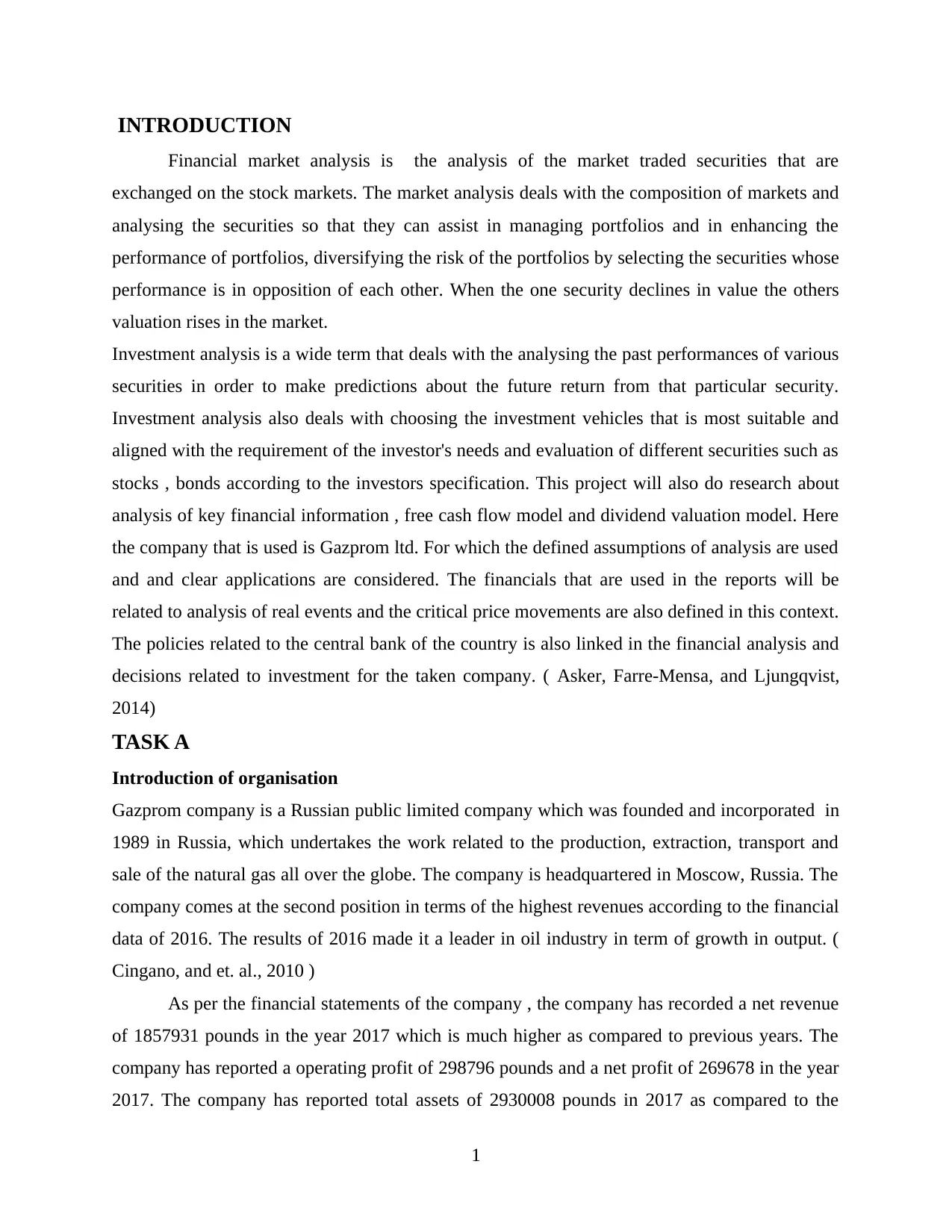
INTRODUCTION
Financial market analysis is the analysis of the market traded securities that are
exchanged on the stock markets. The market analysis deals with the composition of markets and
analysing the securities so that they can assist in managing portfolios and in enhancing the
performance of portfolios, diversifying the risk of the portfolios by selecting the securities whose
performance is in opposition of each other. When the one security declines in value the others
valuation rises in the market.
Investment analysis is a wide term that deals with the analysing the past performances of various
securities in order to make predictions about the future return from that particular security.
Investment analysis also deals with choosing the investment vehicles that is most suitable and
aligned with the requirement of the investor's needs and evaluation of different securities such as
stocks , bonds according to the investors specification. This project will also do research about
analysis of key financial information , free cash flow model and dividend valuation model. Here
the company that is used is Gazprom ltd. For which the defined assumptions of analysis are used
and and clear applications are considered. The financials that are used in the reports will be
related to analysis of real events and the critical price movements are also defined in this context.
The policies related to the central bank of the country is also linked in the financial analysis and
decisions related to investment for the taken company. ( Asker, Farre-Mensa, and Ljungqvist,
2014)
TASK A
Introduction of organisation
Gazprom company is a Russian public limited company which was founded and incorporated in
1989 in Russia, which undertakes the work related to the production, extraction, transport and
sale of the natural gas all over the globe. The company is headquartered in Moscow, Russia. The
company comes at the second position in terms of the highest revenues according to the financial
data of 2016. The results of 2016 made it a leader in oil industry in term of growth in output. (
Cingano, and et. al., 2010 )
As per the financial statements of the company , the company has recorded a net revenue
of 1857931 pounds in the year 2017 which is much higher as compared to previous years. The
company has reported a operating profit of 298796 pounds and a net profit of 269678 in the year
2017. The company has reported total assets of 2930008 pounds in 2017 as compared to the
1
Financial market analysis is the analysis of the market traded securities that are
exchanged on the stock markets. The market analysis deals with the composition of markets and
analysing the securities so that they can assist in managing portfolios and in enhancing the
performance of portfolios, diversifying the risk of the portfolios by selecting the securities whose
performance is in opposition of each other. When the one security declines in value the others
valuation rises in the market.
Investment analysis is a wide term that deals with the analysing the past performances of various
securities in order to make predictions about the future return from that particular security.
Investment analysis also deals with choosing the investment vehicles that is most suitable and
aligned with the requirement of the investor's needs and evaluation of different securities such as
stocks , bonds according to the investors specification. This project will also do research about
analysis of key financial information , free cash flow model and dividend valuation model. Here
the company that is used is Gazprom ltd. For which the defined assumptions of analysis are used
and and clear applications are considered. The financials that are used in the reports will be
related to analysis of real events and the critical price movements are also defined in this context.
The policies related to the central bank of the country is also linked in the financial analysis and
decisions related to investment for the taken company. ( Asker, Farre-Mensa, and Ljungqvist,
2014)
TASK A
Introduction of organisation
Gazprom company is a Russian public limited company which was founded and incorporated in
1989 in Russia, which undertakes the work related to the production, extraction, transport and
sale of the natural gas all over the globe. The company is headquartered in Moscow, Russia. The
company comes at the second position in terms of the highest revenues according to the financial
data of 2016. The results of 2016 made it a leader in oil industry in term of growth in output. (
Cingano, and et. al., 2010 )
As per the financial statements of the company , the company has recorded a net revenue
of 1857931 pounds in the year 2017 which is much higher as compared to previous years. The
company has reported a operating profit of 298796 pounds and a net profit of 269678 in the year
2017. The company has reported total assets of 2930008 pounds in 2017 as compared to the
1
⊘ This is a preview!⊘
Do you want full access?
Subscribe today to unlock all pages.

Trusted by 1+ million students worldwide
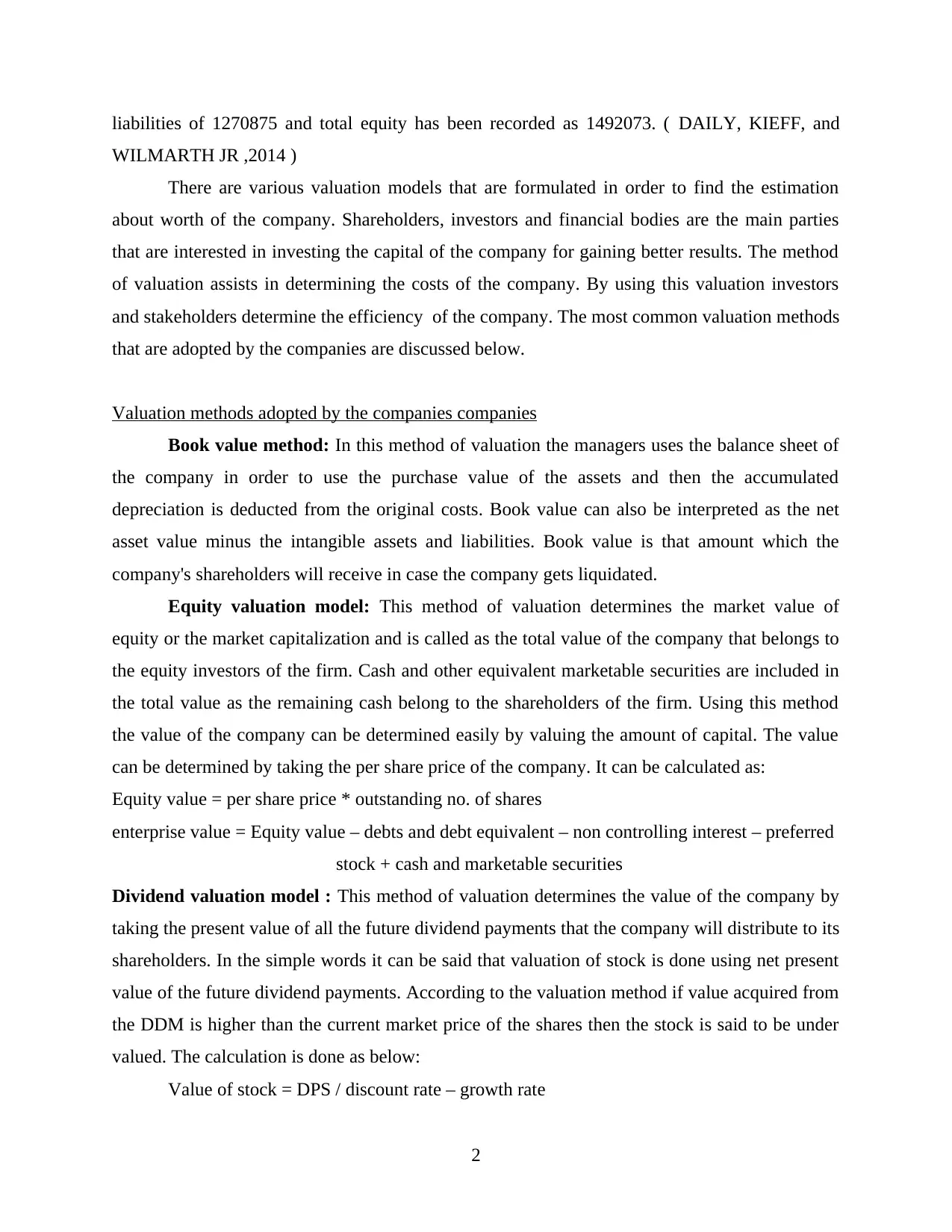
liabilities of 1270875 and total equity has been recorded as 1492073. ( DAILY, KIEFF, and
WILMARTH JR ,2014 )
There are various valuation models that are formulated in order to find the estimation
about worth of the company. Shareholders, investors and financial bodies are the main parties
that are interested in investing the capital of the company for gaining better results. The method
of valuation assists in determining the costs of the company. By using this valuation investors
and stakeholders determine the efficiency of the company. The most common valuation methods
that are adopted by the companies are discussed below.
Valuation methods adopted by the companies companies
Book value method: In this method of valuation the managers uses the balance sheet of
the company in order to use the purchase value of the assets and then the accumulated
depreciation is deducted from the original costs. Book value can also be interpreted as the net
asset value minus the intangible assets and liabilities. Book value is that amount which the
company's shareholders will receive in case the company gets liquidated.
Equity valuation model: This method of valuation determines the market value of
equity or the market capitalization and is called as the total value of the company that belongs to
the equity investors of the firm. Cash and other equivalent marketable securities are included in
the total value as the remaining cash belong to the shareholders of the firm. Using this method
the value of the company can be determined easily by valuing the amount of capital. The value
can be determined by taking the per share price of the company. It can be calculated as:
Equity value = per share price * outstanding no. of shares
enterprise value = Equity value – debts and debt equivalent – non controlling interest – preferred
stock + cash and marketable securities
Dividend valuation model : This method of valuation determines the value of the company by
taking the present value of all the future dividend payments that the company will distribute to its
shareholders. In the simple words it can be said that valuation of stock is done using net present
value of the future dividend payments. According to the valuation method if value acquired from
the DDM is higher than the current market price of the shares then the stock is said to be under
valued. The calculation is done as below:
Value of stock = DPS / discount rate – growth rate
2
WILMARTH JR ,2014 )
There are various valuation models that are formulated in order to find the estimation
about worth of the company. Shareholders, investors and financial bodies are the main parties
that are interested in investing the capital of the company for gaining better results. The method
of valuation assists in determining the costs of the company. By using this valuation investors
and stakeholders determine the efficiency of the company. The most common valuation methods
that are adopted by the companies are discussed below.
Valuation methods adopted by the companies companies
Book value method: In this method of valuation the managers uses the balance sheet of
the company in order to use the purchase value of the assets and then the accumulated
depreciation is deducted from the original costs. Book value can also be interpreted as the net
asset value minus the intangible assets and liabilities. Book value is that amount which the
company's shareholders will receive in case the company gets liquidated.
Equity valuation model: This method of valuation determines the market value of
equity or the market capitalization and is called as the total value of the company that belongs to
the equity investors of the firm. Cash and other equivalent marketable securities are included in
the total value as the remaining cash belong to the shareholders of the firm. Using this method
the value of the company can be determined easily by valuing the amount of capital. The value
can be determined by taking the per share price of the company. It can be calculated as:
Equity value = per share price * outstanding no. of shares
enterprise value = Equity value – debts and debt equivalent – non controlling interest – preferred
stock + cash and marketable securities
Dividend valuation model : This method of valuation determines the value of the company by
taking the present value of all the future dividend payments that the company will distribute to its
shareholders. In the simple words it can be said that valuation of stock is done using net present
value of the future dividend payments. According to the valuation method if value acquired from
the DDM is higher than the current market price of the shares then the stock is said to be under
valued. The calculation is done as below:
Value of stock = DPS / discount rate – growth rate
2
Paraphrase This Document
Need a fresh take? Get an instant paraphrase of this document with our AI Paraphraser
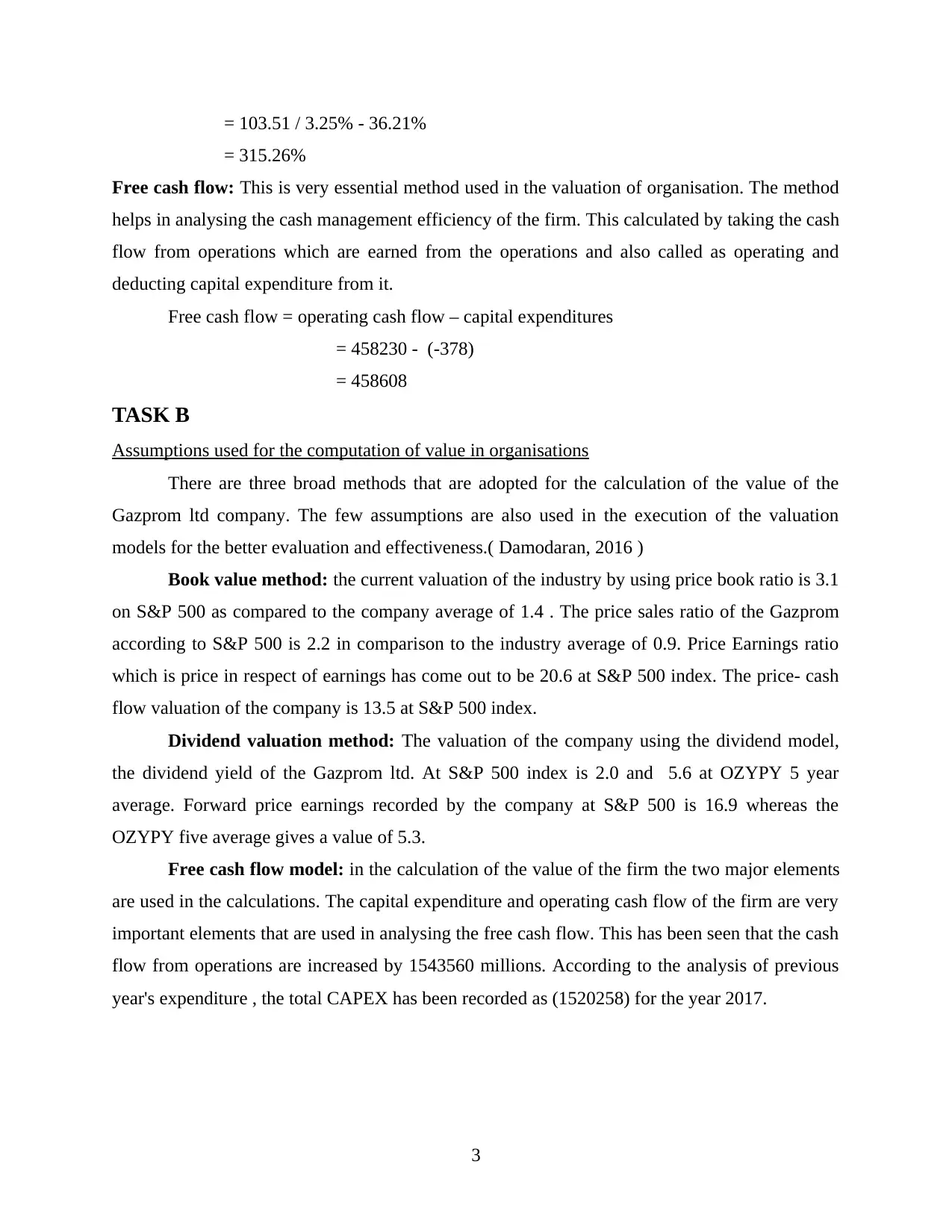
= 103.51 / 3.25% - 36.21%
= 315.26%
Free cash flow: This is very essential method used in the valuation of organisation. The method
helps in analysing the cash management efficiency of the firm. This calculated by taking the cash
flow from operations which are earned from the operations and also called as operating and
deducting capital expenditure from it.
Free cash flow = operating cash flow – capital expenditures
= 458230 - (-378)
= 458608
TASK B
Assumptions used for the computation of value in organisations
There are three broad methods that are adopted for the calculation of the value of the
Gazprom ltd company. The few assumptions are also used in the execution of the valuation
models for the better evaluation and effectiveness.( Damodaran, 2016 )
Book value method: the current valuation of the industry by using price book ratio is 3.1
on S&P 500 as compared to the company average of 1.4 . The price sales ratio of the Gazprom
according to S&P 500 is 2.2 in comparison to the industry average of 0.9. Price Earnings ratio
which is price in respect of earnings has come out to be 20.6 at S&P 500 index. The price- cash
flow valuation of the company is 13.5 at S&P 500 index.
Dividend valuation method: The valuation of the company using the dividend model,
the dividend yield of the Gazprom ltd. At S&P 500 index is 2.0 and 5.6 at OZYPY 5 year
average. Forward price earnings recorded by the company at S&P 500 is 16.9 whereas the
OZYPY five average gives a value of 5.3.
Free cash flow model: in the calculation of the value of the firm the two major elements
are used in the calculations. The capital expenditure and operating cash flow of the firm are very
important elements that are used in analysing the free cash flow. This has been seen that the cash
flow from operations are increased by 1543560 millions. According to the analysis of previous
year's expenditure , the total CAPEX has been recorded as (1520258) for the year 2017.
3
= 315.26%
Free cash flow: This is very essential method used in the valuation of organisation. The method
helps in analysing the cash management efficiency of the firm. This calculated by taking the cash
flow from operations which are earned from the operations and also called as operating and
deducting capital expenditure from it.
Free cash flow = operating cash flow – capital expenditures
= 458230 - (-378)
= 458608
TASK B
Assumptions used for the computation of value in organisations
There are three broad methods that are adopted for the calculation of the value of the
Gazprom ltd company. The few assumptions are also used in the execution of the valuation
models for the better evaluation and effectiveness.( Damodaran, 2016 )
Book value method: the current valuation of the industry by using price book ratio is 3.1
on S&P 500 as compared to the company average of 1.4 . The price sales ratio of the Gazprom
according to S&P 500 is 2.2 in comparison to the industry average of 0.9. Price Earnings ratio
which is price in respect of earnings has come out to be 20.6 at S&P 500 index. The price- cash
flow valuation of the company is 13.5 at S&P 500 index.
Dividend valuation method: The valuation of the company using the dividend model,
the dividend yield of the Gazprom ltd. At S&P 500 index is 2.0 and 5.6 at OZYPY 5 year
average. Forward price earnings recorded by the company at S&P 500 is 16.9 whereas the
OZYPY five average gives a value of 5.3.
Free cash flow model: in the calculation of the value of the firm the two major elements
are used in the calculations. The capital expenditure and operating cash flow of the firm are very
important elements that are used in analysing the free cash flow. This has been seen that the cash
flow from operations are increased by 1543560 millions. According to the analysis of previous
year's expenditure , the total CAPEX has been recorded as (1520258) for the year 2017.
3
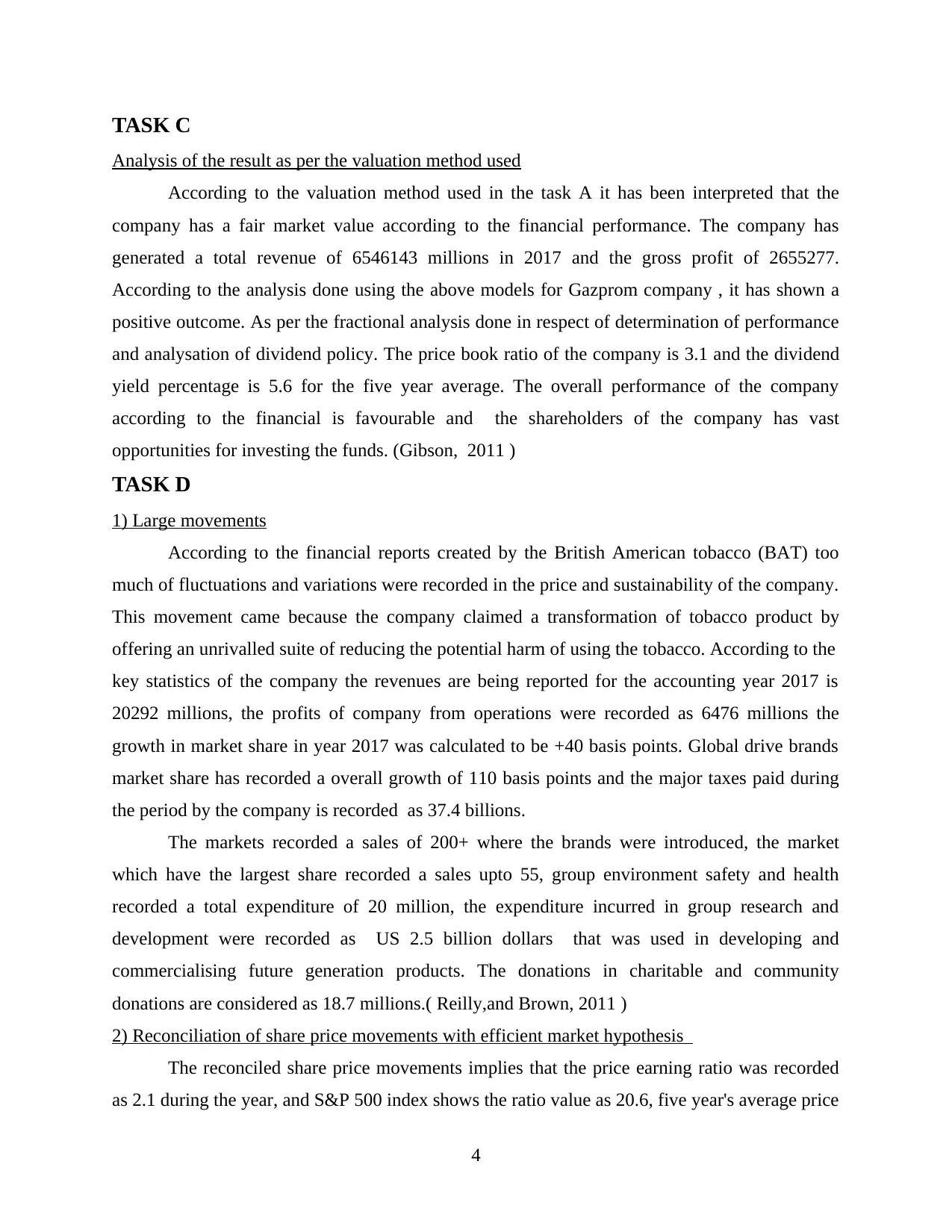
TASK C
Analysis of the result as per the valuation method used
According to the valuation method used in the task A it has been interpreted that the
company has a fair market value according to the financial performance. The company has
generated a total revenue of 6546143 millions in 2017 and the gross profit of 2655277.
According to the analysis done using the above models for Gazprom company , it has shown a
positive outcome. As per the fractional analysis done in respect of determination of performance
and analysation of dividend policy. The price book ratio of the company is 3.1 and the dividend
yield percentage is 5.6 for the five year average. The overall performance of the company
according to the financial is favourable and the shareholders of the company has vast
opportunities for investing the funds. (Gibson, 2011 )
TASK D
1) Large movements
According to the financial reports created by the British American tobacco (BAT) too
much of fluctuations and variations were recorded in the price and sustainability of the company.
This movement came because the company claimed a transformation of tobacco product by
offering an unrivalled suite of reducing the potential harm of using the tobacco. According to the
key statistics of the company the revenues are being reported for the accounting year 2017 is
20292 millions, the profits of company from operations were recorded as 6476 millions the
growth in market share in year 2017 was calculated to be +40 basis points. Global drive brands
market share has recorded a overall growth of 110 basis points and the major taxes paid during
the period by the company is recorded as 37.4 billions.
The markets recorded a sales of 200+ where the brands were introduced, the market
which have the largest share recorded a sales upto 55, group environment safety and health
recorded a total expenditure of 20 million, the expenditure incurred in group research and
development were recorded as US 2.5 billion dollars that was used in developing and
commercialising future generation products. The donations in charitable and community
donations are considered as 18.7 millions.( Reilly,and Brown, 2011 )
2) Reconciliation of share price movements with efficient market hypothesis
The reconciled share price movements implies that the price earning ratio was recorded
as 2.1 during the year, and S&P 500 index shows the ratio value as 20.6, five year's average price
4
Analysis of the result as per the valuation method used
According to the valuation method used in the task A it has been interpreted that the
company has a fair market value according to the financial performance. The company has
generated a total revenue of 6546143 millions in 2017 and the gross profit of 2655277.
According to the analysis done using the above models for Gazprom company , it has shown a
positive outcome. As per the fractional analysis done in respect of determination of performance
and analysation of dividend policy. The price book ratio of the company is 3.1 and the dividend
yield percentage is 5.6 for the five year average. The overall performance of the company
according to the financial is favourable and the shareholders of the company has vast
opportunities for investing the funds. (Gibson, 2011 )
TASK D
1) Large movements
According to the financial reports created by the British American tobacco (BAT) too
much of fluctuations and variations were recorded in the price and sustainability of the company.
This movement came because the company claimed a transformation of tobacco product by
offering an unrivalled suite of reducing the potential harm of using the tobacco. According to the
key statistics of the company the revenues are being reported for the accounting year 2017 is
20292 millions, the profits of company from operations were recorded as 6476 millions the
growth in market share in year 2017 was calculated to be +40 basis points. Global drive brands
market share has recorded a overall growth of 110 basis points and the major taxes paid during
the period by the company is recorded as 37.4 billions.
The markets recorded a sales of 200+ where the brands were introduced, the market
which have the largest share recorded a sales upto 55, group environment safety and health
recorded a total expenditure of 20 million, the expenditure incurred in group research and
development were recorded as US 2.5 billion dollars that was used in developing and
commercialising future generation products. The donations in charitable and community
donations are considered as 18.7 millions.( Reilly,and Brown, 2011 )
2) Reconciliation of share price movements with efficient market hypothesis
The reconciled share price movements implies that the price earning ratio was recorded
as 2.1 during the year, and S&P 500 index shows the ratio value as 20.6, five year's average price
4
⊘ This is a preview!⊘
Do you want full access?
Subscribe today to unlock all pages.

Trusted by 1+ million students worldwide
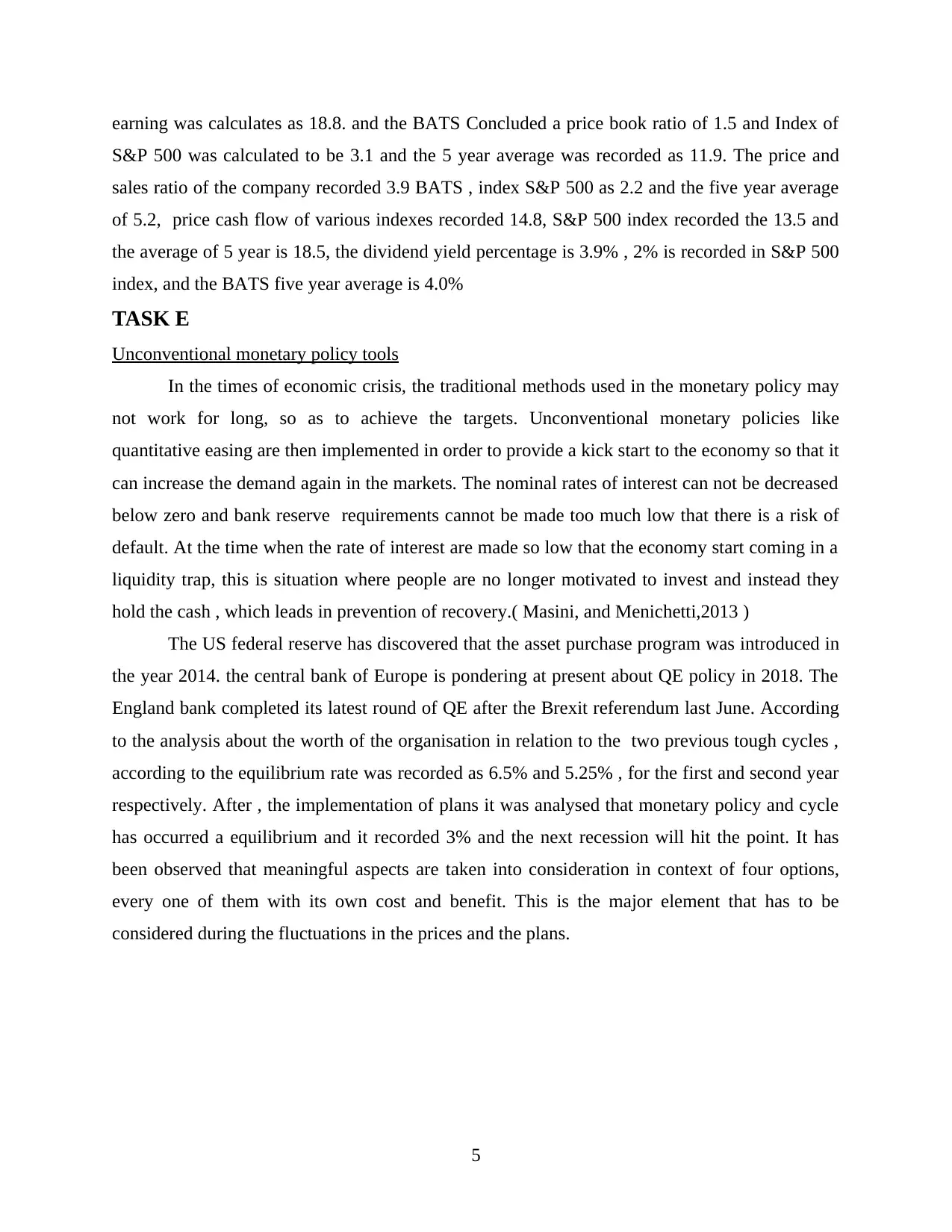
earning was calculates as 18.8. and the BATS Concluded a price book ratio of 1.5 and Index of
S&P 500 was calculated to be 3.1 and the 5 year average was recorded as 11.9. The price and
sales ratio of the company recorded 3.9 BATS , index S&P 500 as 2.2 and the five year average
of 5.2, price cash flow of various indexes recorded 14.8, S&P 500 index recorded the 13.5 and
the average of 5 year is 18.5, the dividend yield percentage is 3.9% , 2% is recorded in S&P 500
index, and the BATS five year average is 4.0%
TASK E
Unconventional monetary policy tools
In the times of economic crisis, the traditional methods used in the monetary policy may
not work for long, so as to achieve the targets. Unconventional monetary policies like
quantitative easing are then implemented in order to provide a kick start to the economy so that it
can increase the demand again in the markets. The nominal rates of interest can not be decreased
below zero and bank reserve requirements cannot be made too much low that there is a risk of
default. At the time when the rate of interest are made so low that the economy start coming in a
liquidity trap, this is situation where people are no longer motivated to invest and instead they
hold the cash , which leads in prevention of recovery.( Masini, and Menichetti,2013 )
The US federal reserve has discovered that the asset purchase program was introduced in
the year 2014. the central bank of Europe is pondering at present about QE policy in 2018. The
England bank completed its latest round of QE after the Brexit referendum last June. According
to the analysis about the worth of the organisation in relation to the two previous tough cycles ,
according to the equilibrium rate was recorded as 6.5% and 5.25% , for the first and second year
respectively. After , the implementation of plans it was analysed that monetary policy and cycle
has occurred a equilibrium and it recorded 3% and the next recession will hit the point. It has
been observed that meaningful aspects are taken into consideration in context of four options,
every one of them with its own cost and benefit. This is the major element that has to be
considered during the fluctuations in the prices and the plans.
5
S&P 500 was calculated to be 3.1 and the 5 year average was recorded as 11.9. The price and
sales ratio of the company recorded 3.9 BATS , index S&P 500 as 2.2 and the five year average
of 5.2, price cash flow of various indexes recorded 14.8, S&P 500 index recorded the 13.5 and
the average of 5 year is 18.5, the dividend yield percentage is 3.9% , 2% is recorded in S&P 500
index, and the BATS five year average is 4.0%
TASK E
Unconventional monetary policy tools
In the times of economic crisis, the traditional methods used in the monetary policy may
not work for long, so as to achieve the targets. Unconventional monetary policies like
quantitative easing are then implemented in order to provide a kick start to the economy so that it
can increase the demand again in the markets. The nominal rates of interest can not be decreased
below zero and bank reserve requirements cannot be made too much low that there is a risk of
default. At the time when the rate of interest are made so low that the economy start coming in a
liquidity trap, this is situation where people are no longer motivated to invest and instead they
hold the cash , which leads in prevention of recovery.( Masini, and Menichetti,2013 )
The US federal reserve has discovered that the asset purchase program was introduced in
the year 2014. the central bank of Europe is pondering at present about QE policy in 2018. The
England bank completed its latest round of QE after the Brexit referendum last June. According
to the analysis about the worth of the organisation in relation to the two previous tough cycles ,
according to the equilibrium rate was recorded as 6.5% and 5.25% , for the first and second year
respectively. After , the implementation of plans it was analysed that monetary policy and cycle
has occurred a equilibrium and it recorded 3% and the next recession will hit the point. It has
been observed that meaningful aspects are taken into consideration in context of four options,
every one of them with its own cost and benefit. This is the major element that has to be
considered during the fluctuations in the prices and the plans.
5
Paraphrase This Document
Need a fresh take? Get an instant paraphrase of this document with our AI Paraphraser
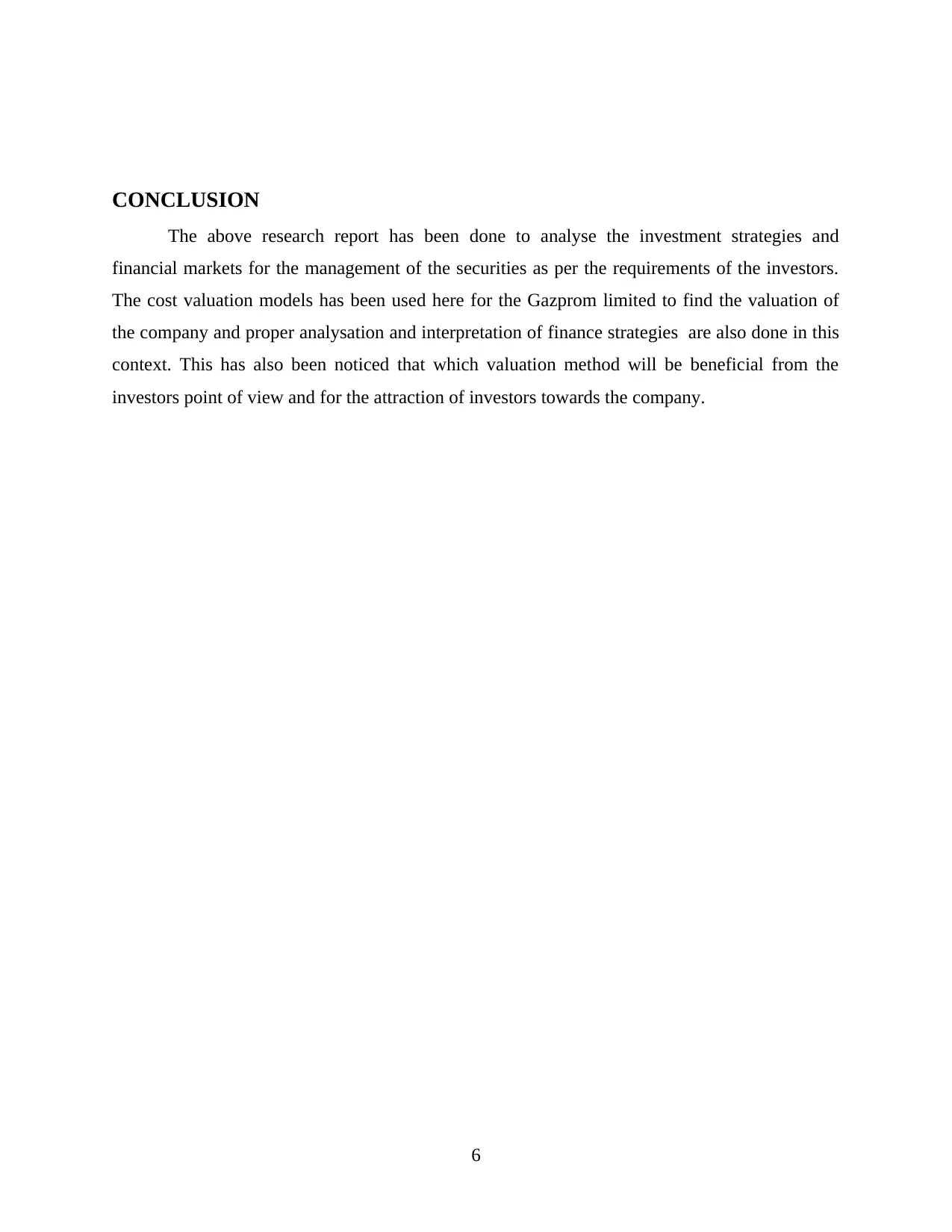
CONCLUSION
The above research report has been done to analyse the investment strategies and
financial markets for the management of the securities as per the requirements of the investors.
The cost valuation models has been used here for the Gazprom limited to find the valuation of
the company and proper analysation and interpretation of finance strategies are also done in this
context. This has also been noticed that which valuation method will be beneficial from the
investors point of view and for the attraction of investors towards the company.
6
The above research report has been done to analyse the investment strategies and
financial markets for the management of the securities as per the requirements of the investors.
The cost valuation models has been used here for the Gazprom limited to find the valuation of
the company and proper analysation and interpretation of finance strategies are also done in this
context. This has also been noticed that which valuation method will be beneficial from the
investors point of view and for the attraction of investors towards the company.
6
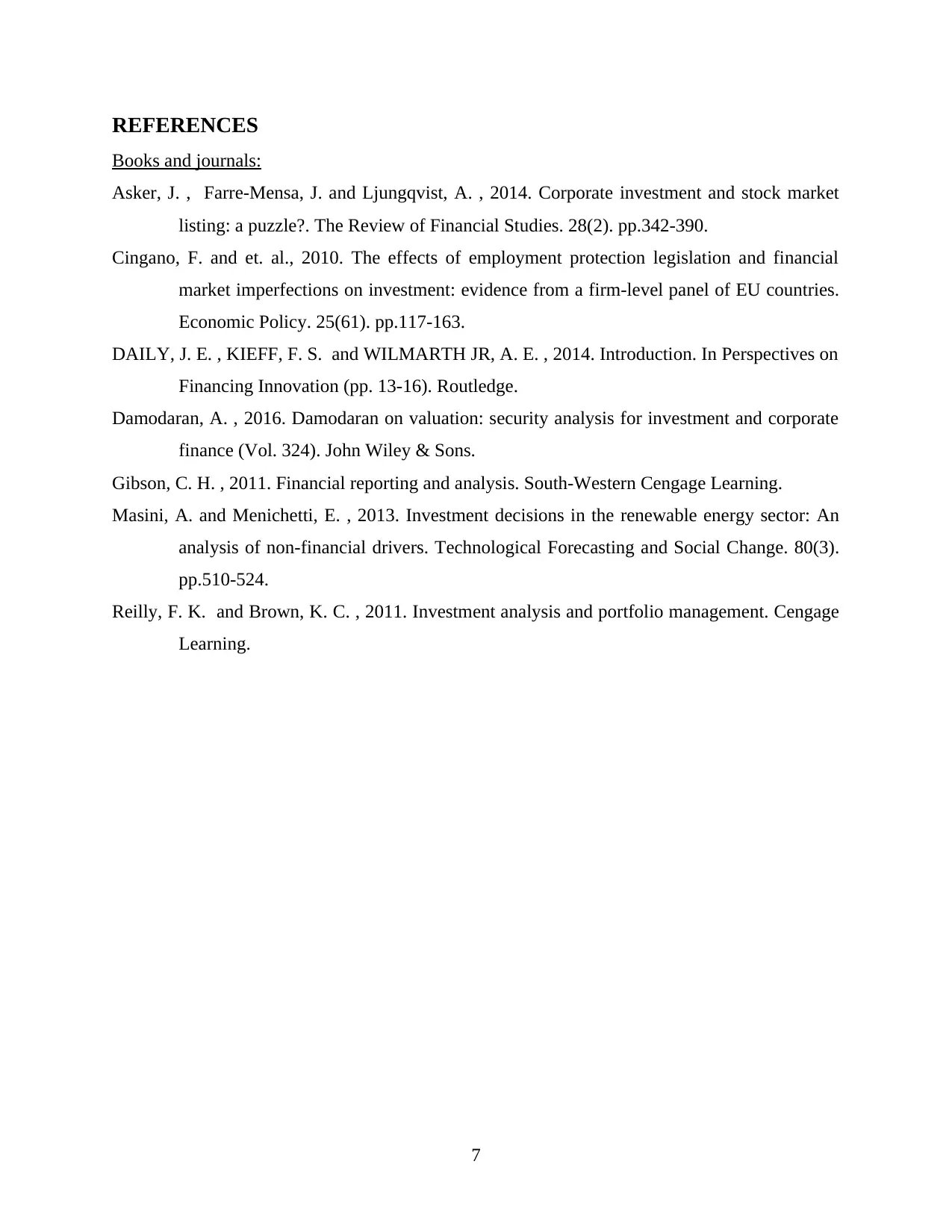
REFERENCES
Books and journals:
Asker, J. , Farre-Mensa, J. and Ljungqvist, A. , 2014. Corporate investment and stock market
listing: a puzzle?. The Review of Financial Studies. 28(2). pp.342-390.
Cingano, F. and et. al., 2010. The effects of employment protection legislation and financial
market imperfections on investment: evidence from a firm-level panel of EU countries.
Economic Policy. 25(61). pp.117-163.
DAILY, J. E. , KIEFF, F. S. and WILMARTH JR, A. E. , 2014. Introduction. In Perspectives on
Financing Innovation (pp. 13-16). Routledge.
Damodaran, A. , 2016. Damodaran on valuation: security analysis for investment and corporate
finance (Vol. 324). John Wiley & Sons.
Gibson, C. H. , 2011. Financial reporting and analysis. South-Western Cengage Learning.
Masini, A. and Menichetti, E. , 2013. Investment decisions in the renewable energy sector: An
analysis of non-financial drivers. Technological Forecasting and Social Change. 80(3).
pp.510-524.
Reilly, F. K. and Brown, K. C. , 2011. Investment analysis and portfolio management. Cengage
Learning.
7
Books and journals:
Asker, J. , Farre-Mensa, J. and Ljungqvist, A. , 2014. Corporate investment and stock market
listing: a puzzle?. The Review of Financial Studies. 28(2). pp.342-390.
Cingano, F. and et. al., 2010. The effects of employment protection legislation and financial
market imperfections on investment: evidence from a firm-level panel of EU countries.
Economic Policy. 25(61). pp.117-163.
DAILY, J. E. , KIEFF, F. S. and WILMARTH JR, A. E. , 2014. Introduction. In Perspectives on
Financing Innovation (pp. 13-16). Routledge.
Damodaran, A. , 2016. Damodaran on valuation: security analysis for investment and corporate
finance (Vol. 324). John Wiley & Sons.
Gibson, C. H. , 2011. Financial reporting and analysis. South-Western Cengage Learning.
Masini, A. and Menichetti, E. , 2013. Investment decisions in the renewable energy sector: An
analysis of non-financial drivers. Technological Forecasting and Social Change. 80(3).
pp.510-524.
Reilly, F. K. and Brown, K. C. , 2011. Investment analysis and portfolio management. Cengage
Learning.
7
⊘ This is a preview!⊘
Do you want full access?
Subscribe today to unlock all pages.

Trusted by 1+ million students worldwide
1 out of 9
Related Documents
Your All-in-One AI-Powered Toolkit for Academic Success.
+13062052269
info@desklib.com
Available 24*7 on WhatsApp / Email
![[object Object]](/_next/static/media/star-bottom.7253800d.svg)
Unlock your academic potential
Copyright © 2020–2025 A2Z Services. All Rights Reserved. Developed and managed by ZUCOL.





